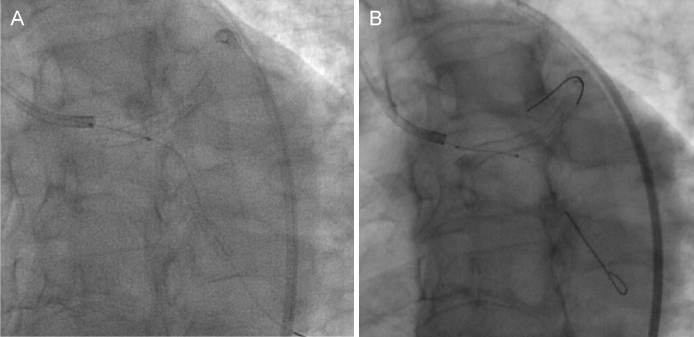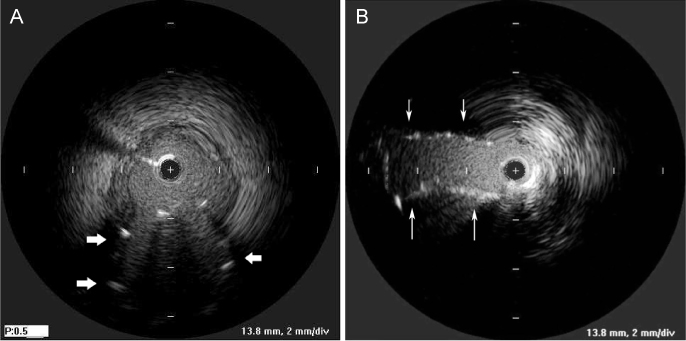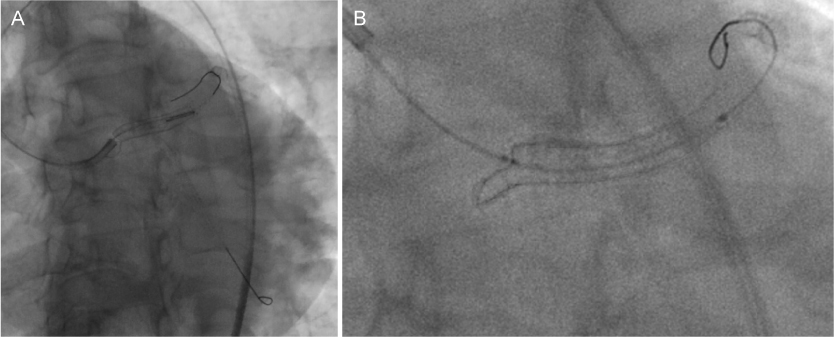J Lipid Atheroscler.
2015 Dec;4(2):149-152. 10.12997/jla.2015.4.2.149.
Undermining and Ballooning the Proximal Part of the Left Main Coronary Artery Stent Resulting in an Iatrogenic Stent Deformation
- Affiliations
-
- 1Department of Cardiology, Cardiovascular Center, Korea University Anam Hospital, Seoul, Korea. psyche94@gmail.com
- KMID: 2151825
- DOI: http://doi.org/10.12997/jla.2015.4.2.149
Abstract
- We present a case of a 52-year-old woman with iatrogenic stent deformation occurred after deployment of the left main (LM) stent due to the unintentional undermining of the proximal part of the LM stent with subsequent balloon dilatation. We tried to crush the deformed part of the LM stent against the left coronary cusp by pushing it with a guiding catheter. The deformed stent was stabilized after stent crushing and the patient didn't have any cardiovascular events. This case highlights that stent deformation could be successfully managed by crushing the deformed part of the stent to the coronary sinus.
MeSH Terms
Figure
Reference
-
1. Ota H, Kitabata H, Magalhaes MA, Bui A, Kardenas K, Thomas CH, et al. Comparison of frequency and severity of longitudinal stent deformation among various drug-eluting stents: an intravascular ultrasound study. Int J Cardiol. 2014; 175:261–267.
Article2. Al-Moghairi AM, Al-Amri HS. Management of retained intervention guide-wire: a literature review. Curr Cardiol Rev. 2013; 9:260–266.
Article3. Trehan V, Mukhopadhyay S, Yusuf J, C Ramgasetty U, Mukherjee S, Arora R. Intracoronary fracture and embolization of a coronary angioplasty balloon catheter: retrieval by a simple technique. Catheter Cardiovasc Interv. 2003; 58:473–477.
Article4. Collins N, Horlick E, Dzavik V. Triple wire technique for removal of fractured angioplasty guidewire. J Invasive Cardiol. 2007; 19:E230–E234.5. Alomar ME, Michael TT, Patel VG, Altomare CG, Rangan BV, Cipher D, et al. Stent loss and retrieval during percutaneous coronary interventions: a systematic review and meta-analysis. J Invasive Cardiol. 2013; 25:637–641.6. Cha KS. Surgical retrieval of dislodged stent during transradial coronary intervention. J Invasive Cardiol. 2012; 24:E179–E181.7. Prasad A, Ilapakurti M, Ravandi A. Successful retrieval of a frayed coronary stent using the peripheral crossover technique. J Invasive Cardiol. 2011; 23:E69–E71.
- Full Text Links
- Actions
-
Cited
- CITED
-
- Close
- Share
- Similar articles
-
- Coronary Stent Fracture in a Patient with an Atrial Septal Defect and Severe Pulmonary Hypertension
- Spontaneous resolution of new coronary artery aneurysm following guideline-directed medical therapy after drug-eluting stent implantation
- Dislodgement of Two Stents in One Patient during Percutaneous Coronary Intervention
- Percutaneous Treatment of an Injured Coronary Stent Using the Looping Wire Technique
- Treatment of Stent Dislodgement Complicated by Coronary Artery Dissection using Parallel Wire Technique and Small Balloon





